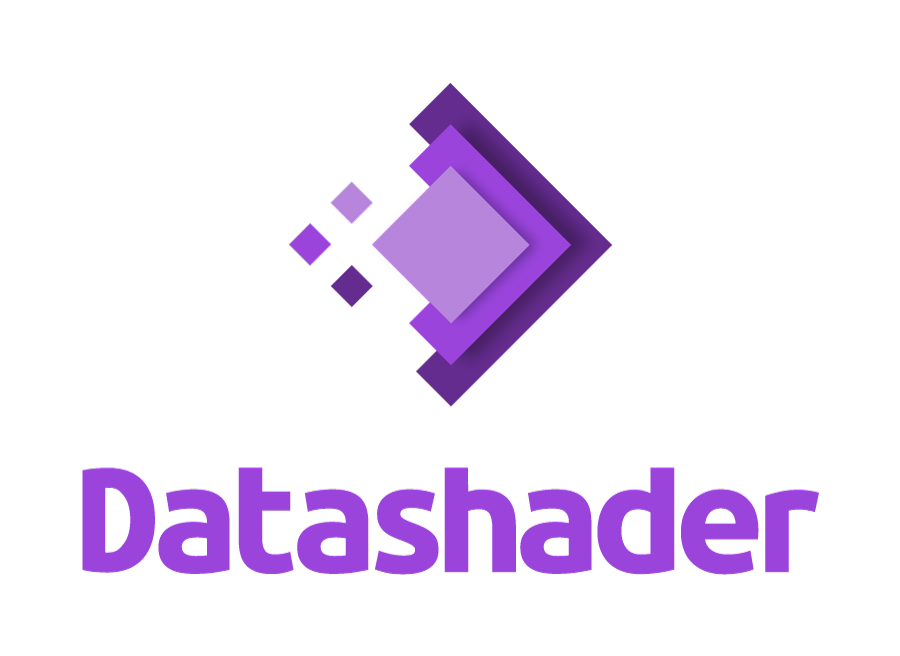Data visualization toolchain based on aggregating into a grid
Project description
Turn even the largest data into images, accurately
| Build Status |  |
| Coverage |  |
| Latest dev release |   |
| Latest release |      |
| Python |  |
| Docs |   |
| Support |  |
What is it?
Datashader is a data rasterization pipeline for automating the process of creating meaningful representations of large amounts of data. Datashader breaks the creation of images of data into 3 main steps:
-
Projection
Each record is projected into zero or more bins of a nominal plotting grid shape, based on a specified glyph.
-
Aggregation
Reductions are computed for each bin, compressing the potentially large dataset into a much smaller aggregate array.
-
Transformation
These aggregates are then further processed, eventually creating an image.
Using this very general pipeline, many interesting data visualizations can be created in a performant and scalable way. Datashader contains tools for easily creating these pipelines in a composable manner, using only a few lines of code. Datashader can be used on its own, but it is also designed to work as a pre-processing stage in a plotting library, allowing that library to work with much larger datasets than it would otherwise.
Installation
Datashader supports Python 3.7, 3.8, 3.9 and 3.10 on Linux, Windows, or Mac and can be installed with conda:
conda install datashader
or with pip:
pip install datashader
For the best performance, we recommend using conda so that you are sure
to get numerical libraries optimized for your platform. The latest
releases are avalailable on the pyviz channel conda install -c pyviz datashader and the latest pre-release versions are avalailable on the
dev-labelled channel conda install -c pyviz/label/dev datashader.
Fetching Examples
Once you've installed datashader as above you can fetch the examples:
datashader examples
cd datashader-examples
This will create a new directory called datashader-examples with all the data needed to run the examples.
To run all the examples you will need some extra dependencies. If you installed datashader within a conda environment, with that environment active run:
conda env update --file environment.yml
Otherwise create a new environment:
conda env create --name datashader --file environment.yml
conda activate datashader
Developer Instructions
-
Install Python 3 miniconda or anaconda, if you don't already have it on your system.
-
Clone the datashader git repository if you do not already have it:
git clone git://github.com/holoviz/datashader.git -
Set up a new conda environment with all of the dependencies needed to run the examples:
cd datashader conda env create --name datashader --file ./examples/environment.yml conda activate datashader -
Put the datashader directory into the Python path in this environment:
pip install --no-deps -e .
Learning more
After working through the examples, you can find additional resources linked from the datashader documentation, including API documentation and papers and talks about the approach.
Some Examples
Project details
Release history Release notifications | RSS feed
Download files
Download the file for your platform. If you're not sure which to choose, learn more about installing packages.
Source Distribution
Built Distribution
File details
Details for the file datashader-0.14.4.tar.gz.
File metadata
- Download URL: datashader-0.14.4.tar.gz
- Upload date:
- Size: 35.6 MB
- Tags: Source
- Uploaded using Trusted Publishing? No
- Uploaded via: twine/4.0.2 CPython/3.7.12
File hashes
| Algorithm | Hash digest | |
|---|---|---|
| SHA256 | 0241e611f951be3245972708e5a769bb183afbfceeec3cf2eef6d80af7756fbd |
|
| MD5 | 0195055a4f164a8c788c1eb3981b9621 |
|
| BLAKE2b-256 | 7aa2a7d17168008184ab8d6bafb5cb1ebf4cde762a8a2f8b0acbbb8c216c902f |
Provenance
File details
Details for the file datashader-0.14.4-py2.py3-none-any.whl.
File metadata
- Download URL: datashader-0.14.4-py2.py3-none-any.whl
- Upload date:
- Size: 18.2 MB
- Tags: Python 2, Python 3
- Uploaded using Trusted Publishing? No
- Uploaded via: twine/4.0.2 CPython/3.7.12
File hashes
| Algorithm | Hash digest | |
|---|---|---|
| SHA256 | 5c27efd7c36f3638f7c31aa6ce84c7318df4494f69c6e401d79dea367db79578 |
|
| MD5 | a1b6bae97f239e9eb4245d6e8eca2c4c |
|
| BLAKE2b-256 | 7062bdabf3731ac6a20399f2cfff12dbf65826f7ab102a9db4784dfe640fb648 |



















